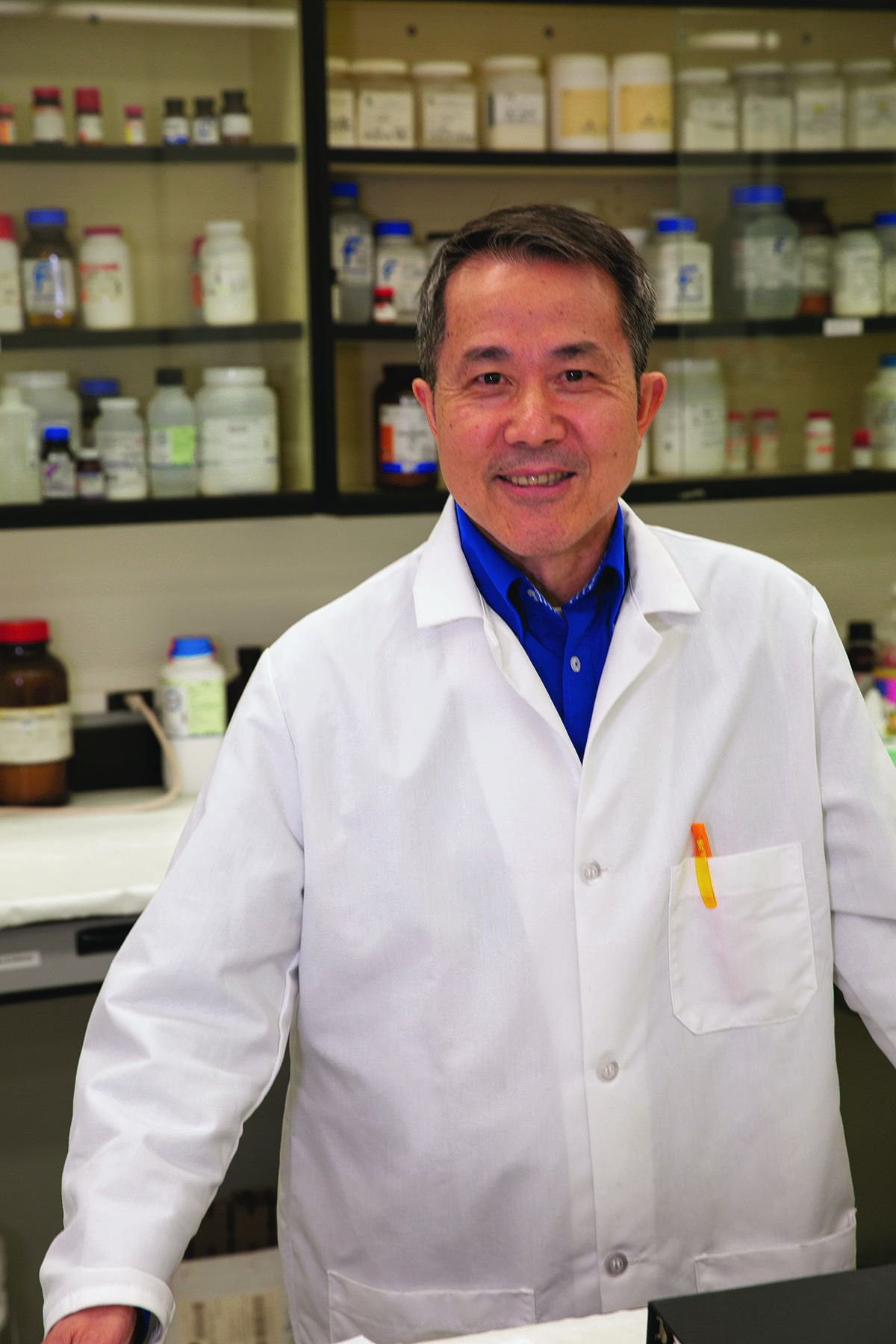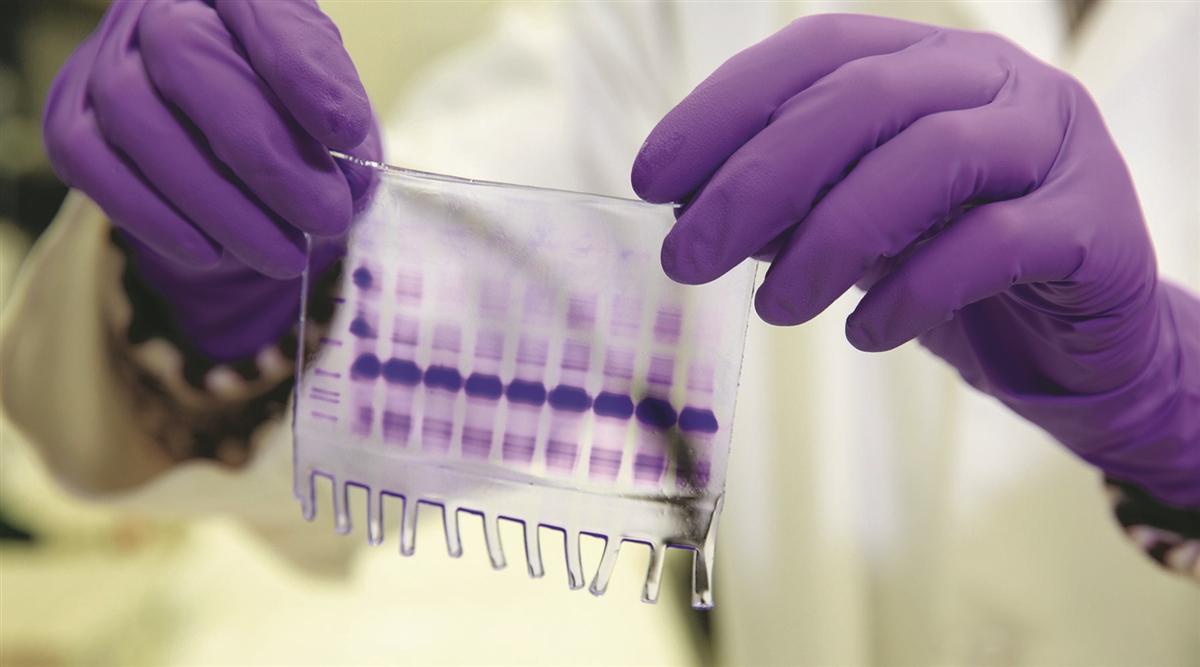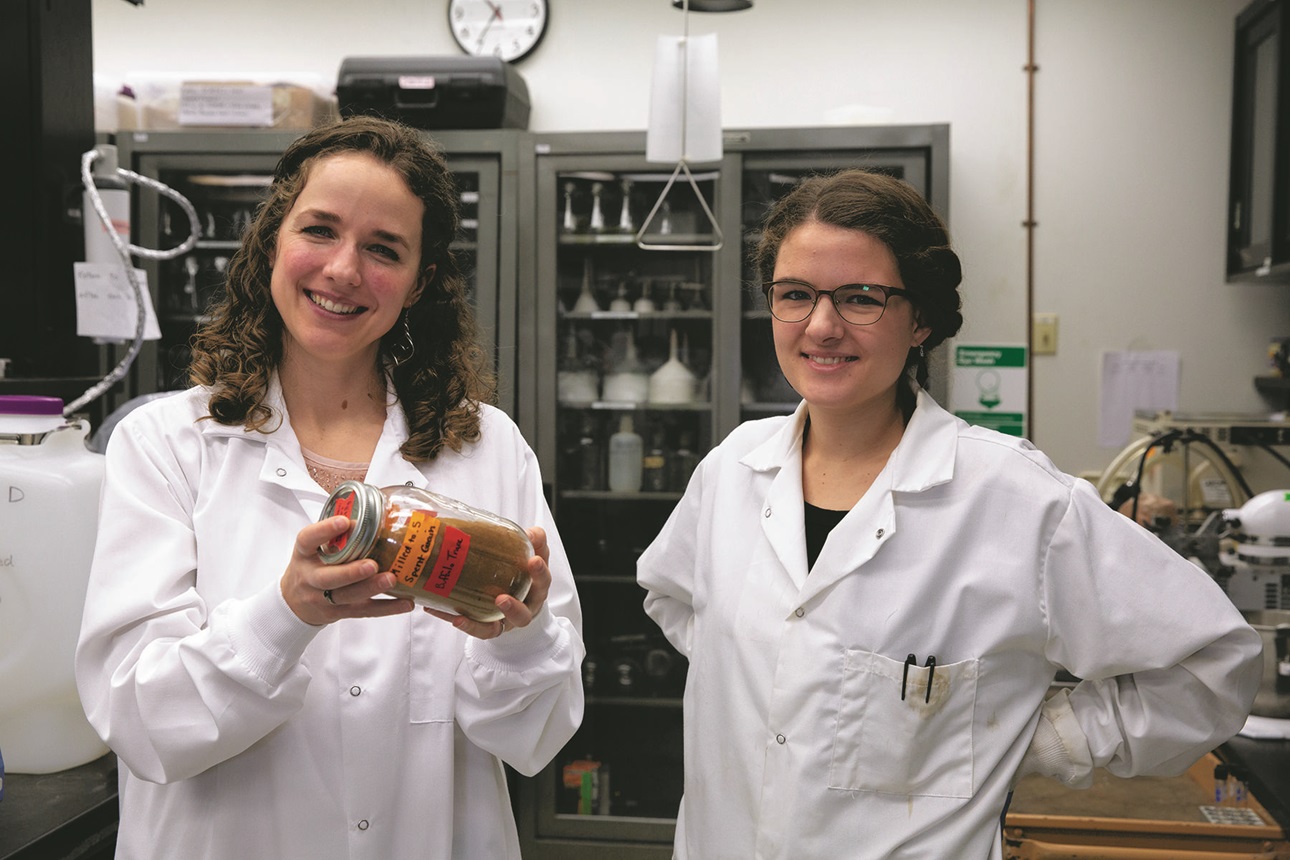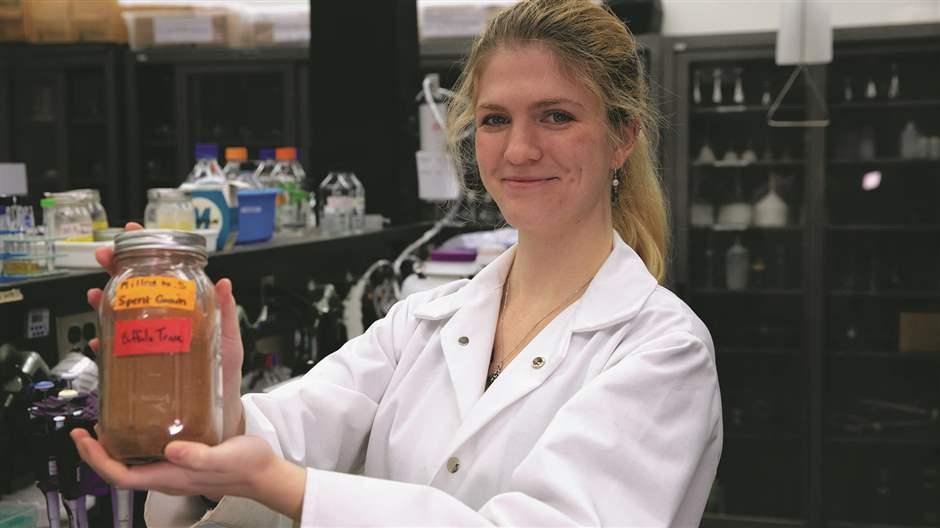
Food Chemistry Is Thriving in Bourbon Country
The food chemistry research at the University of Kentucky fosters new product development.
Article Content
Without food chemists, would new food products exist? Every aspect of growing food, combining ingredients, developing complex flavor, cooking food, and storing it relies on food chemistry. This is because every food or ingredient that grows in a field or sits on a supermarket shelf is made up of chemicals, so for food to exist, a series of chemical reactions must take place. At the University of Kentucky, researchers in the Department of Animal and Food Sciences explore the components of food, the chemical molecules behind their existence, their nutritional value, the bioactive properties of food compounds, and techniques to transform them into health-promoting food ingredients and functional foods.
Food Chemistry 101
Food chemistry is the study of the functions of food components, the interactions between food molecules, and the effects of chemical and physical processes (such as fermenting, frying, or freezing) on food. Every food consists of compounds that define its nutrition, quality, safety, and toxicity. “In my personal opinion—I may be biased a little bit—food chemistry is the core of food science. Food safety is very important, but food chemistry really gets down to the molecular level to explain how individual molecules interact—how they interact in the food system under different processing conditions to create different types of organoleptic properties like aroma, texture, [and] pigments/ color,” says Youling Xiong, a professor in the Department of Animal and Food Sciences at the University of Kentucky. Food chemistry provides answers to what happens to food during processing, cooking, storing, combining, and consumption. “Food chemistry is really important to food science because it allows us to explain at a basic chemical level what is going on in a food. We are able to identify parts and pieces of the food and then see how they change when we put those pieces together or process them or when we eat them,” says Rachel Schendel, an assistant professor in the Department of Animal and Food Sciences at the University of Kentucky.
Carbohydrates, lipids, and proteins are the primary chemical components of food, and food chemistry utilizes all the principles of chemistry to investigate them. In doing so, food chemistry is crucial to product development. “Food chemistry helps guide the product development process by giving us insight into how a particular food is going to behave when we process it or when we store it on the shelf. It helps us choose ingredients that will protect foods from spoilage or oxidation, and food chemistry helps us also predict foods that will have health benefits for consumers,” Schendel says. Xiong agrees, adding, “Without a thorough understanding of the chemical reactions occurring in food during processing and storage, it is very difficult to come up with a niche concept for new products. Any new products—the quality, organoleptic properties, sensory properties, even ingredient safety— could go back down to the basic chemical reactions. I think [there] is a direct link linkage between the chemical reactions in food and the success of a new product,” says Xiong. He and Schendel thus explore the biochemical and functional properties of certain food components and use them to create novel ingredients.
The Protein Path to New Products
Xiong and his research team study proteins, which are complex macromolecules that are integral for several functions (e.g., antibody, enzyme, messenger, structural, etc.) in the human body. Whether in an animal product or a plant food, a protein is comprised of hundreds or thousands of 20 different amino acids; nine of them cannot be produced by the human body, so humans must get them from dietary foods. These nine amino acids (histidine, isoleucine, leucine, lysine, methionine, phenylalanine, threonine, tryptophan, and valine) are called essential amino acids. Animal foods contain all of the amino acids, including the nine essential amino acids, so they are complete protein sources. Most plant foods do not provide all the essential amino acids that humans need, so they are not complete sources of proteins. Nonetheless, as the demand for more plant-based foods increases, food product developers are relying more on plant proteins to develop meat- and dairyalternative products. “Plant proteins, in general, are not as nutritious as animal proteins. However, what we can do is combine different plant proteins to make up the deficiencies,” Xiong says. Consequently, one of the research areas in Xiong’s laboratory is figuring out ways to increase the functionality of plant proteins, such as modifying them to mimic animal proteins and function better during food processing.
“Plant proteins are now being increasingly utilized to create new types of foods that are not traditionally available. For example, meat alternatives (some people call them meat analogues) … are created from plant proteins mostly. Now we can easily see the importance of plant proteins and their functionality,” Xiong asserts. Creating a product that mimics dairy or meat products from plants requires isolating proteins from plants and manipulating them to resemble, behave, and taste like dairy and meat products. This is not easy as animal proteins are fibrous while plant proteins are mostly globular, but Xiong and other food chemists have devised techniques to make plant proteins behave like animal proteins. “In general, plant proteins are kind of compact; the molecules are compact … like globulins. Globulins tend to form trimers or hexamers,” Xiong explains. “They do not dissolve in water easily, so you really need to break up the [polymers] to create individual monomers. Individual monomers will still have compact structure, and you need to modify that structure to make sure it is partially open. When those structures open up, then you have what we call hydrophobic amino acids that will start to work with lipids to create an emulsion to stabilize fat.” This process is often used to create plant-based dairy alternative beverages; the modification allows the plant proteins to stay suspended in water longer but isn’t foolproof, which is why some plant-based dairy alternatives need to be shaken well before consumption. To combat this issue, some dairy alternative beverages contain stabilizers (e.g., carrageenan, xanthan, or another highly viscous polysaccharide), which eliminates the need for them to be vigorously shaken before consumption. However, the addition of stabilizers in plant-based dairy alternatives creates mouthfeel or textural issues that some consumers find unpleasant.
For plant-based products that resemble meat, the process is slightly different. “You start with a protein, you extract the protein, you create emulsions, and you add proteins directly and a little carbohydrate (maybe polysaccharide) to interact and create a type of texture. And we can do extrusion, for example, through thermal high-pressure processing and create a type of fibrous structure that can mimic meat,” Xiong says. “Whether or not they’re really healthy, we don’t know.” Even though the number of plant-based meat and dairy alternative products on the market seems to increase every day, they still fall short of completely replicating the taste, texture, and mouthfeel of animal products: “Have we achieved 100% success? I would say no. Still, we cannot totally replace meat proteins or animal proteins [with] plant proteins,” Xiong says, but he and other food scientists, as well as several food companies, are working on it.
Another focus of Xiong’s laboratory is creating functional and bioactive peptides. Peptides are protein fragments, some of which are functional in foods or bioactive in humans. Produced by cleaving proteins with protein-chopping enzymes called proteases, peptides are multifunctional ingredients, according to Xiong. “Some of them will react with free radicals, some of them will balance the pH, [and] some of them will probably serve as an inhibitor of certain enzymes in our bodies to create more optimal health conditions,” he says. Xiong and his research team began doing research on peptides in the early 1990s, creating bioactive peptides from whey protein. “We call them bioactive [because] they can regulate high blood pressure by inhibiting ACE-converting enzyme and also serve as antioxidants in the body to remove some free radicals,” Xiong reveals. “In food, some of the peptides have unique functionalities. For example, they can regulate the viscosity of food because they tend to have very good solubility. And some of them can serve as antioxidants in food.” Antioxidants in foods prevent food components from oxidizing. “Lipids, because of the presence of multiple double bonds within that hydrocarbon chain, are very susceptible to free radical attack. And that, through a cascade of reactions, leads to free radicals and also some short-chain hydrocarbons that tend to generate undesirable aroma. And some of these products are also harmful to the body,” Xiong says. Despite the fact that oxidation is usually categorized as detrimental to foods, Xiong has determined that some oxidative changes in foods can be beneficial. “We conducted quite a few projects to demonstrate that mild oxidation could be desirable in terms of food quality,” Xiong points out, referring to his laboratory’s research on using oxidative enzymes to modify proteins. “Without mild oxidation, we may not have as much complex aroma in cooked food. Protein oxidation … is responsible for textural changes— sometimes aroma.” For example, when cysteine in gluten reacts with oxygen, creating a disulfide bond, the rheology properties of bread dough improve; this is an example of an oxidation of protein that is beneficial.
The Bourbon Trail to Prebiotics
While the Xiong laboratory explores the bioactive and functional properties of proteins, Schendel and her research team are investigating novel sources of a particular category of carbohydrates: prebiotics. Prebiotics are nondigestible carbohydrates including resistant starch, non-starch polysaccharides, nondigestible oligosaccharides, and sugar alcohols. “A prebiotic passes through your stomach and large intestine unscathed—it just skates right through. But then, by definition, when it hits your large intestine (which is where all of your gut bacteria are hanging out), ... the prebiotic needs to be fermented by those gut bacteria and provide some sort of measurable health benefit to the host and also promote the growth of healthpromoting bacteria,” Schendel explains. “A prebiotic is food for the bacteria.” Prebiotics are always plant foods containing fiber, but not all plant foods are prebiotics. In addition, prebiotics help transform the gut into an inhospitable acidic environment for pathogenic bacteria, fortify the intestinal lining, and help regulate immune responses. “The effect of prebiotics on human health varies somewhat based on their individual structures, but in general,” Schendel clarifies, “… if you consume prebiotics, you’ll see fermentation in your large intestine, the production of some shortchain fatty acids (which have some downstream health effects), and then a potential shift in the bacteria population in your large intestine. So the ecological makeup, which species you have growing in your large intestine, will vary based on what you feed them.”
Schendel and her team recently determined that a product made in Kentucky indirectly serves as a novel source for prebiotics. Kentucky is the birthplace of bourbon, which is a type of whiskey distilled from a grain mixture that must be at least 51% corn (the other grains are barley, rye, and wheat); it is also where 95% of the global supply of bourbon is produced. “There are distilleries all around the university and throughout the state, and they’re producing just immense amounts of bourbon every day,” Schendel says. “Left behind in the process is all the parts of the grain that the yeast didn’t ferment in that initial brewing step. Those grains are called spent grains.” Bourbon spent grains are rich in fiber but mostly end up in landfills and sometimes used as animal feed. The most abundant fiber in bourbon spent grains is a type of polysaccharide called arabinoxylan. “All of the true grains contain arabinoxylans in their cell walls. Arabinoxylans are the most abundant hemicellulose polysaccharide there. So, for example, all of the true grains include wheat, rye, oats, barley, corn, sorghum, [and] millet,” Schendel says. The arabinoxylans in bourbon spent grains are a largely untapped source of a functional prebiotic ingredient called arabinoxylan oligosaccharide, which feeds and stimulates the growth of beneficial bacteria in the gut. “Our idea is to take those spent grains, which are rich in [arabinoxylans], and digest them with fiber-chopping enzymes, and then isolate the oligosaccharides (or the small carbohydrate pieces), and [use] those as prebiotic food ingredients … for humans,” Schendel reveals. “Also, because the arabinoxylans in spent grains carry a phenolic acid called ferulic acid (which is a known antioxidant), this ingredient that we’re producing thus has both prebiotic and antioxidant properties.” Only certain bacteria in the gut will ferment arabinoxylan oligosaccharides. “So you’ll start getting different metabolic by-products produced by this population in response to this different structure,” Schendel explains. “The structure that you eat affects the bacteria that grow, which affects the by-products that are produced, which affects your body’s physiological response to it.” This prebiotic ingredient is still in the development stage, but Schendel predicts that it would be ideal for use in yogurt or other dairy products and in breads and other baked goods.
Thus, in the land of spirits lies a foundation for food product ideas: While Xiong and his team’s research on modifying plant proteins informs the development of plant-based replacements for animal products, Schendel and her team are working to upcycle spent grains into an ingredient that could be used in health-promoting products. Their other food chemistry projects involving bioactive peptides and natural antioxidants also have food application potential. Kentucky may be bourbon country, but it is also a wellspring of product innovation powered by the food chemistry research at the University of Kentucky.













